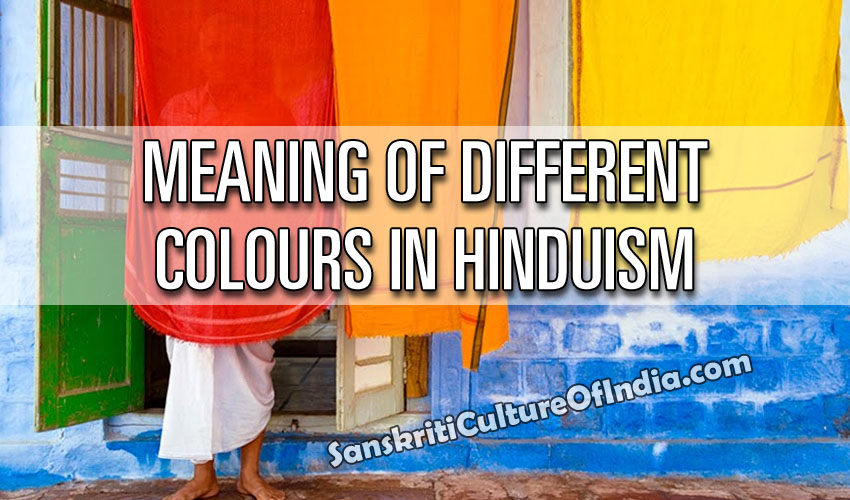Colours play an important part in how we perceive and interact with the world. It seems that each colour emits specific signals that affect our mental, physical and psychological states.
It has now been proven that colours can dramatically affect moods, feelings and emotions to the point of increasing metabolism, raising blood pressure and even cause an eye strain. Red, orange and yellow are known as warm colours that evoke feelings of warmth and comfort, but also of passion, anger and hostility. On the other hand, blue, purple and green are cool colours that bring calmness as well as feelings of sadness.
In Hinduism, colours play a very important role and have deep significance, transcending purely decorative values. Hindu artists use colours on the deities and their dresses signifying their qualities. Proper use of colours creates an environment, which should keep a person cheerful. Some of the main colours used in religious ceremonies are red, yellow (turmeric), green from leaves, white from wheat flour. etc.
RED:
Red indicates both sensuality and purity. In Hindu religion, red is of utmost significance and the colours most frequently used for auspicious occasions like marriages, birth of a child, festivals, etc. A red mark is put on the forehead during ceremonies and important occasions.
As a sign of marriage, women put red powder on the hair parting. They also wear a red sari during marriage. Red powder is usually thrown on statues of deities and phallic symbols during prayers. It is also the colours of Shakti (prowess). A red coloured dress is put on deities who are charitable, brave, protective, and who have the capacity to destroy evil. On the death of a woman, her body is wrapped in a red cloth for the cremation.
SAFFRON:
The most sacred colour for the Hindu is saffron. It represents fire and as impurities are burnt by fire, this colour symbolizes purity. It also represents religious abstinence. This colours connotation has a sacred meaning for the Hindu. It is the colours of holy men and ascetics who have renounced the world. Wearing the colours symbolizes the quest for light. It is the battle colours of the Rajputs, the warrior caste.
GREEN:
Green is a festive colour. In Maharastra, it represents life and happiness. Symbolizing peace and happiness, green stabilizes the mind; the colour is cool to the yes and represents Nature.
YELLOW:
Yellow is the colours of knowledge and learning. It symbolizes happiness, peace, meditation, competence and mental development. It is the colours of spring and activates the mind. Lord Vishnu’s dress is yellow symbolizing his representation of knowledge. Lord Krishna and Ganesha also wear yellow dresses. Yellow clothes are worn and yellow food is eaten at spring festivals. Single girls wear yellow to attract a mate and keep evil spirits away.
WHITE:
White is a mixture of seven different colours hence it symbolizes a little bit of the quality of each. It represents purity, cleanliness, peace and knowledge. The goddess of knowledge, Saraswati is always shown as wearing a white dress, sitting on a white lotus. The Brahmin is associated with white. Hindu religious leaders cover themselves with white ashes to represent their spiritual rebirth. White is also the colours of mourning. The other prominent deities would also have a touch of white on their dress. A Hindu widow would wear a white dress in mourning.
BLUE:
The Creator has given the maximum of blue to nature (i.e.) the sky, the oceans, the rivers and the lakes. The deity who has the qualities of bravery, manliness, determination, the ability to deal with difficult situations, of stable mind and depth of character is represented as blue coloured. Lord Rama and Krishna spent their life protecting humanity and destroying evil, hence they are coloured blue.
Three Gunas, Three Colours, Three Goddesses
In the Bhagawad Gita, the Lord describes the three Gunas, their qualities and expressions:
Purity, passion and inertia – these Gunas, qualities, O mighty-armed, born of Prakriti, bind fast in the body of the embodied, the indestructible. (XIV/5)
Knowledge arises from Sattva; greed from Rajas; heedlessness, delusion and also ignorance arise from Tamas. (XIV/17)
All creation is made up of the three Gunas. These three qualities that comprise and provide a balance to the natural world are symbolized by the colours, white, red and black. Sattva, harmony and purity, is symbolized by white; rajas, energy and passion, is symbolized by red; and tamas, inertia and ignorance, is depicted by black.











